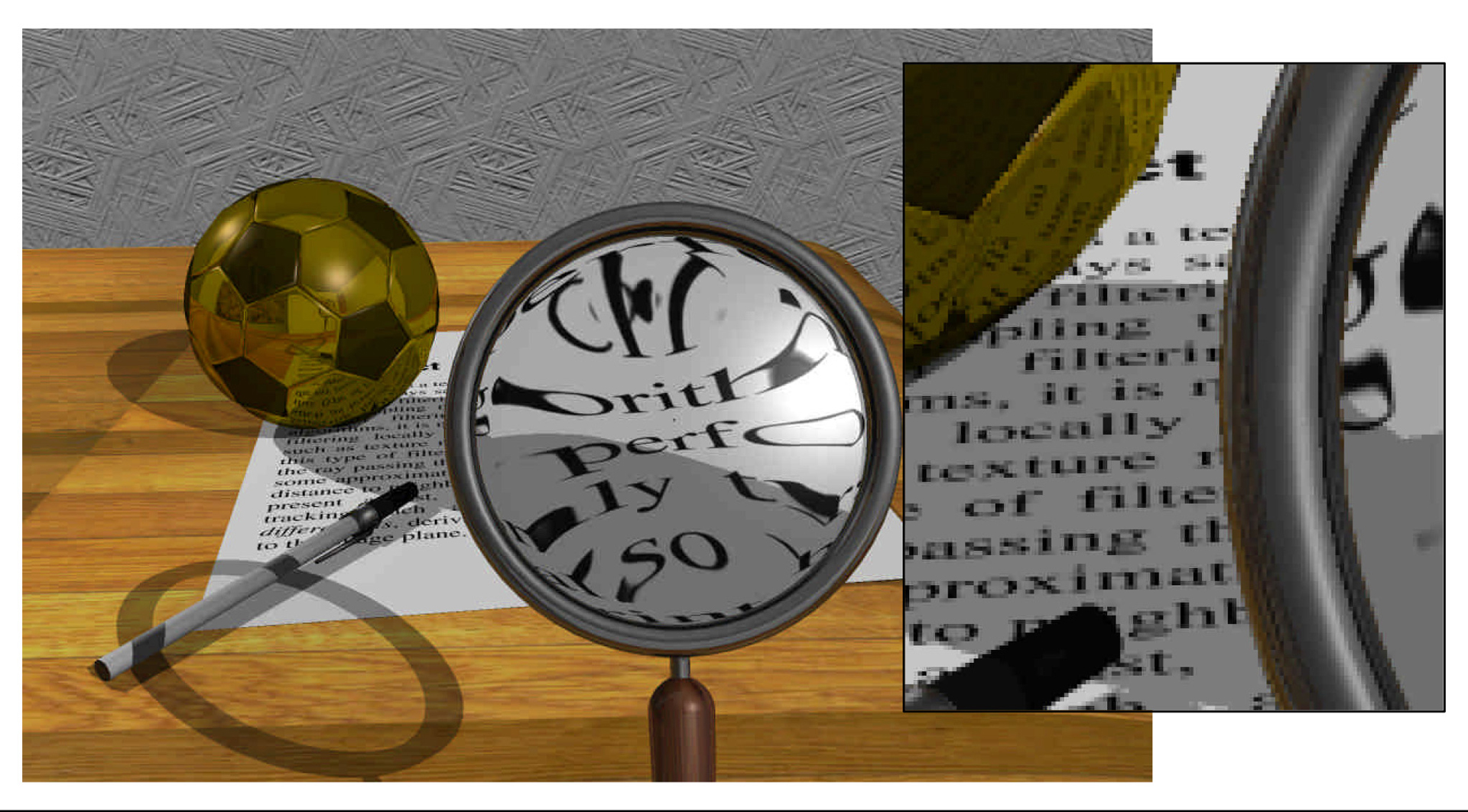“Tracing ray differentials” by Igehy
Conference:
Type(s):
Title:
- Tracing ray differentials
Presenter(s)/Author(s):
Abstract:
Antialiasing of ray traced images is typically performed by supersampling the image plane. While this type of filtering works well for many algorithms, it is much more efficient to perform filtering locally on a surface for algorithms such as texture mapping. In order to perform this type of filtering, one must not only trace the ray passing through the pixel, but also have some approximation of the distance to neighboring rays hitting the surface (i.e., a ray’s footprint). In this paper, we present a fast, simple, robust scheme for tracking such a quantity based on ray differentials, derivatives of the ray with respect to the image plane.
References:
1. K. Akeley. RealityEngine Graphics. Computer Graphics (SIGGRAPH 93 Proceedings), 27, 109-116, 1993.
2. J. Amanatides. Ray Tracing with Cones. Computer Graphics (SIGGRAPH 84 Proceedings), 18, 129-135, 1984.
3. A. Barkans. High-Quality Rendering Using the Talisman Architecture. 1997 SIGGRAPH / Eurographics Workshop on Graphics Hardware, 79-88, 1997.
4. M. Born and E. Wolf. Principles of Optics. Pergamon Press, New York, 190-196, 1959.
5. S. Collins. Adaptive Splatting for Specular to Diffuse Light Transport. Fifth Eurographics Workshop on Rendering, 119-135, 1994.
6. R. Cook, T. Porter, and L. Carpenter. Distributed Ray Tracing. Computer Graphics (SIGGRAPH 84 Proceedings), 18, 137-145, 1984.
7. A. Glassner, ed. An Introduction to Ray Tracing. Academic Press, San Diego, 288-293, 1989.
8. L. Gritz and J. Hahn. BMRT: A Global Illumination Implementation of the RenderMan Standard. Journal of Graphics Tools, 1 (3), 1996.
9. A. Gullstrand. Die reelle optische Abbildun g. Sv. Vetensk. Handl., 41, 1-119, 1906.
10. P. Heckbert. Texture Mapping Polygons in Perspective. NYIT Computer Graphics Lab Technical Memo #13, 1983.
11. J. Loos, P. Slusallek, and H. Seidel. Using Wavefront Tracing for the Visualization and Optimization of Progressive Lenses. Computer Graphics Forum (Eurographics 98 Proceedings), 17(3), 1998.
12. D. Mitchell. Generating Antialiased Images at Low Sampling Densities. Computer Graphics (SIGGRAPH 87 Proceedings), 21, 65-72, 1987.
13. D. Mitchell and P. Hanrahan. Illumination from Curved Reflectors. Computer Graphics (SIGGRAPH 92 Proceedings), 26, 283-291, 1992.
14. H. Pederson. Decorating Implicit Surfaces. Computer Graphics (SIGGRAPH 95 Proceedings), 29, 291-300, 1995.
15. A. Schilling, G. Knittel, and W. Strasser. Texram: A Smart Memory for Texturing. IEEE Computer Graphics and Applications, 16(3), 32-41, 1996.
16. M. Shinya and T. Takahashi. Principles and Applications of Pencil Tracing. Computer Graphics (SIGGRAPH 87 Proceedings), 21, 45-54, 1987.
17. D. Struik. Lectures on Classical Differential Geometry, Second Edition. Dover Publications, New York, 1961.
18. T. Whitted. An Improved Illumination Model for Shaded Displays. Communications of the ACM, 23(6), 343-349, 1980.
19. L. Williams. Pyramidal Parametrics. Computer Graphics (SIGGRAPH 83 Proceedings), 17, 1-11, 1983.





